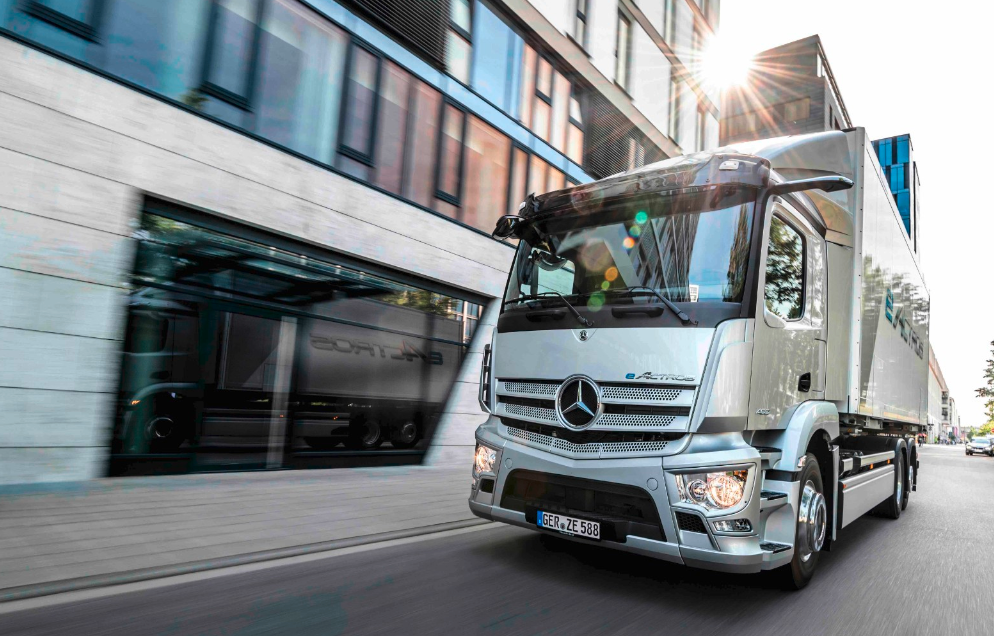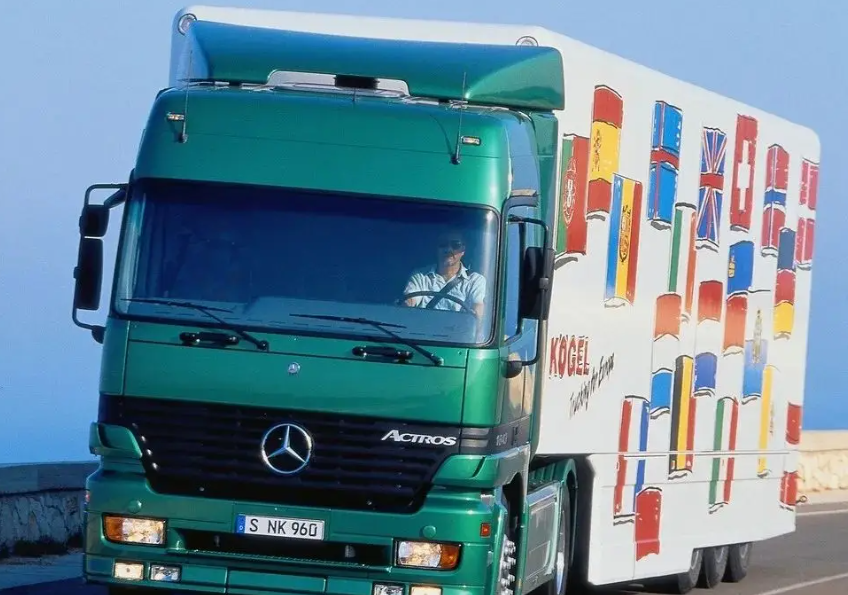Daimler Trucks' Second-quarter 2024 Financial Report Analysis:
Daimler Trucks' Second-quarter 2024 Financial Report Analysis: Challenges and Transformation Opportunities in the Global Commercial Vehicle Market.

Core Data of Financial Reports and Market Performance.
Daimler Trucks' recently released financial report for the first half of 2024 sketches a complex picture of the global commercial vehicle market. Facing the structural adjustment in the industry, the group has made a strategic calibration of its annual business indicators. It is expected that the annual sales volume range will be between 460,000 and 480,000 units, and the revenue target will be set at 53 billion to 55 billion euros.
Based on the data of the second quarter alone, the group's revenue reached 13.3 billion euros, a slight decline compared to 13.9 billion euros in the same period of 2023. Adjusted EBIT was 700 million euros, lower than the 300 million euros in the same period last year (note that the original text may contain a typo, and the 2023 figure might be 1.3 billion euros). The adjusted EBIT of the industrial business segment was 600 million euros, showing a contraction compared to 600 million euros in the same period last year, reflecting the dual challenges of cost pressure and weak demand faced by traditional businesses.
Electrification transformation: The core engine for growth against the trend
Against the backdrop of overall market pressure, Daimler Trucks' electrification strategy has demonstrated strong momentum. In the second quarter of 2024, the sales of pure electric vehicles soared by 69% year-on-year, rising from 383 units in the same period of the previous year to 648 units, highlighting its first-mover advantage in the new energy vehicle sector. In the first half of the year, the cumulative sales of zero-emission models reached 1,461 units, doubling from 670 units in the same period of 2023. This marks a substantial breakthrough for the brand in the commercialization of low-carbon technologies.
3. Regional market differentiation: Adjustment of Traditional Markets and Opportunities in Emerging markets
(1) North American Market: Resilience in Structural Adjustment
The North American market presents the characteristics of "a slight decrease in total volume and regional differentiation". In the first half of 2024, Daimler Trucks sold 94,450 units in North America, slightly lower than the 99,509 units sold in the same period of 2023. In the segmented market, the US market was affected by the shrinking demand for tractors. The sales volume in the first half of the year decreased by 7% year-on-year to 78,859 units, and the downward trend continued in the second quarter (-7% to 39,596 units). In the Mexican market, with the advantage of a localized supply chain, sales increased by 10% in the first half of the year and the growth rate expanded to 23% in the second quarter. The Canadian market remained stable, with a slight increase of 1% in the first half of the year and the growth rate rising to 4% in the second quarter. It is worth noting that the North American heavy-duty truck (Grade 8) market declined by 15% year-on-year in the second quarter, resulting in a cumulative decline of 11% in the first half of the year. This reflects the policy pressure and demand transformation faced by high-emission models.
(2) European market: Strategic Contraction under weak demand
The European market has become the main drag on performance. Mercedes-benz's truck division saw sales drop to 62,489 units in the first half of the year, a 15% decline from 73,728 units in the same period of 2023. In the second quarter, sales reached 30,604 units, a year-on-year decrease of 22%. The market performance in the 30 EU countries was particularly severe. The number of new registrations of heavy trucks dropped by 4% in the first half of the year, and the decline expanded to 3% in the second quarter. Daimler's sales in the region dropped by 27% to 31,720 units in the first half of the year and plunged by 40% to 13,432 units in the second quarter, highlighting the restraining effect of the European energy crisis and economic recession on the demand for commercial vehicles. In contrast, the Brazilian market saw a significant increase in sales in the first half of the year (+57% to 6,846 units) due to the replacement demand brought about by the implementation of the Euro VI emission standards, becoming a regional highlight.
(3) Asian market: Policy Cycles and Demand Fluctuations
The sales volume of the Asian division dropped by 29% year-on-year to 56,799 units in the first half of the year, and 28,342 units were sold in the second quarter, with the decline being consistent with the overall situation. Core markets such as Indonesia, Japan and India have seen their demand shrink to varying degrees due to political cycles (such as the Indonesian presidential election) and the slowdown in economic growth. It is worth noting that the fluctuations in the Southeast Asian market are characterized by short-term policy-driven features, and the long-term growth potential remains to be observed.

Diversified business support: The strategic value of financial services and R&D investment
The financial services sector has become a stabilizer for performance. In the first half of the year, the amount of newly signed financial lease contracts reached 5.8 billion euros, an increase of 17% year-on-year. Among them, the European (+32%) and North American (+14%) markets made significant contributions. As of the end of June, the total contract value reached 30.4 billion euros, an increase of 7% compared with the end of the previous year, reflecting the brand's integration capabilities in the field of industrial chain finance.
R&d investment has been continuously tilting towards electrification and intelligence. In the first half of the year, R&D expenditure reached 400 million euros (including capitalization), representing a year-on-year increase of 96% (note that there may be unit errors in the original text, which could be 960 million euros). In the second quarter alone, expenditure was 3.1 billion euros (or 310 million euros), showing a significant year-on-year growth. This investment structure indicates that the group is building its future competitiveness through technological innovation, with a focus on areas such as battery technology, autonomous driving, and the Internet of Vehicles.
Full-year outlook: Policy Variables and Market Recovery Expectations
Daimler Trucks holds a "cautiously optimistic" attitude towards the global economic situation. It is expected that the global economic growth rate will slightly slow to 5% in 2024 (this might be a writing error of 3.5%, which needs to be corrected in combination with actual macroeconomic data), the growth in the Eurozone will be weak (up to 0%), and the decline in the US inflation rate is expected to drive a shift in monetary policy. Boost economic growth (expected to be 5%). It is worth noting that the new mandatory standards for vehicle safety systems, which will be implemented starting from July 2024, may drive market recovery through technological upgrade demands. Particularly in mature markets such as Europe and North America, compliance replacement may become a growth point for sales in the second half of the year.
Strategic Implications: The Competitive Logic during the Industry's Transformation Period.
The financial report of Daimler Trucks reveals three major transformation trends in the commercial vehicle industry:
(1) The irreversibility of electrification: The rapid growth of zero-emission models confirms the correctness of the technical route. In the future, the competition for market share will focus on the layout of charging infrastructure and the control of battery costs.
(2) Regional market rebalancing: The policy cycles in emerging markets (such as Latin America and Southeast Asia) and the regulatory upgrades in mature markets jointly constitute the dual-wheel drive of the global layout.
(3) Service-oriented transformation: The stable performance of the financial services sector highlights the strategic value of transforming from a "vehicle manufacturer" to a "transportation solution provider".
During the industry's stressful period, Daimler Trucks is attempting to establish new competitive advantages in the transformation of the commercial vehicle industry by proactively adjusting its business expectations, strengthening technological investment and optimizing its regional structure. Its performance in the second half of the year will depend on the pace of macroeconomic recovery, the efficiency of policy dividend release and the market penetration rate of electric products.


发表评论 取消回复